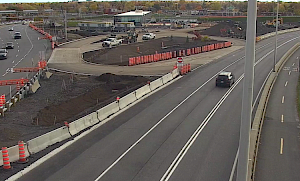- © 2025 The Jacques Cartier and Champlain Bridges Incorporated
- Terms of Use
- Site Map
On December 21, 1978, the Corporation became responsible for the management, maintenance and monitoring of the Champlain Bridge.
The bridge is officially closed to traffic in the summer of 2019 and its deconstruction began a year later in August 2020.
JCCBI would like to thank all the consultants who contributed, through their expertise and commitment, to the success of this major infrastructure project.
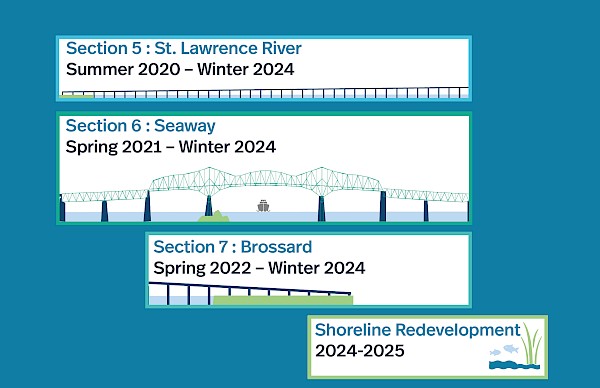
The work was divided into three sections. This global schedule shows the major upcoming milestones for the different sections of the Champlain Bridge.
Section 5: St. Lawrence River
Above the St. Lawrence River to the Seaway, the work was carried out in the water and had little impact on mobility.
Section 6: Seaway
Above the St. Lawrence Seaway, most of the work was carried out mainly in winter 2022 and 2023 to avoid disrupting marine transportation.
Section 7: Brossard
Work began in spring 2022.

JCCBI wanted to mark the end of the deconstruction of the original Champlain Bridge by given out to the public a rivet taken from its steel structure at two events held over the weekend on September 9 and 10 in Brossard and on Île des Soeurs.
The Jacques Cartier and Champlain Bridges Incorporated also announced the 11 projects confirmed through the pan-Canadian Material Reuse Competition. The goal of this unique initiative was to give a second life to over 400 steel components.
JCCBI launched this competition in June 2021 as part of its efforts to minimize the environmental footprint of the Champlain Bridge deconstruction. Here are the 11 recreational, artistic, commemorative and community projects that were selected:
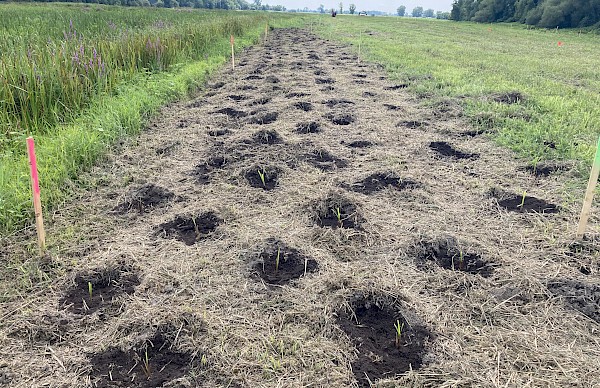
Another highlight from 2022 was the completion of Phase 2 of the Saint-Ignace-de-Loyola compensation project. A total of 30,000 shrubs and herbaceous plants and 300 trees were planted in just one month.
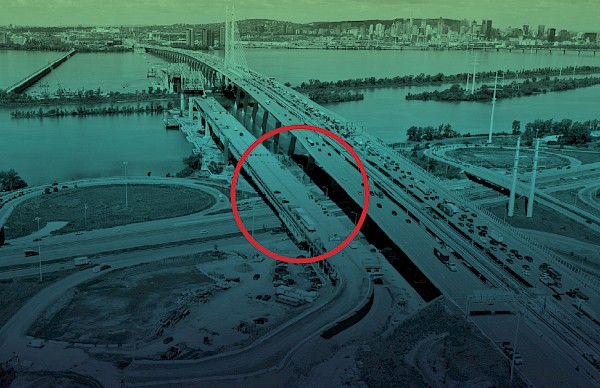
Major work blitzes were held in the fall in the sector of Hwy. 132 as part of the deconstruction process for the original Champlain Bridge. The spans above Hwy. 132 as well as their supporting piers were demolished in a key milestone for this major project.
The lowering of the main span of the original Champlain Bridge in January was the result of nearly two years of detailed design, coordination and planning. Taking down a suspended span under changing winter conditions was not only a major engineering achievement but also a Canadian first!
The Jacques Cartier and Champlain Bridges Incorporated (JCCBI) announced that the selected tenderer for the deconstruction of the original Champlain Bridge will be the Nouvel Horizon St-Laurent consortium formed by Pomerleau Inc. and Delsan-A.I.M. Environmental Services Inc.
Before the deconstruction of the original Champlain Bridge starts, JCCBI offered unique guided tours to the public. These historic 90-minute tours were presented in collaboration with Heritage Montreal in November 2019. Visitors to the bridge could capture never-before-seen images and enjoy a memorable experience!
The original Champlain Bridge was officially closed to traffic, and motorists started travelling on the new Samuel De Champlain Bridge. A historical moment.
An emotional day as we say #byebyeChamplain
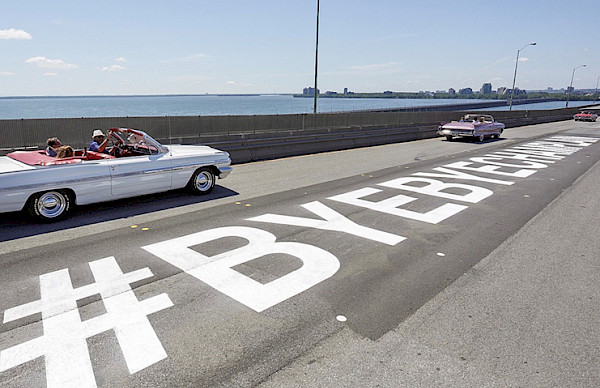
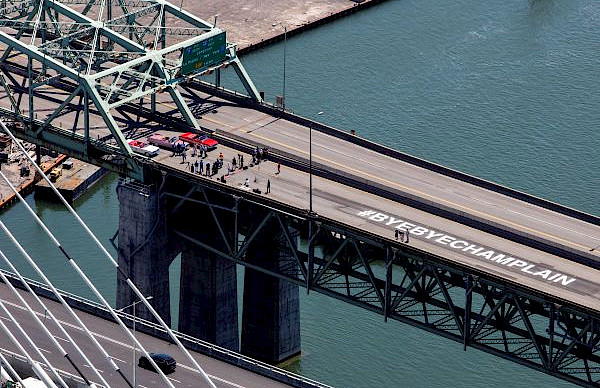
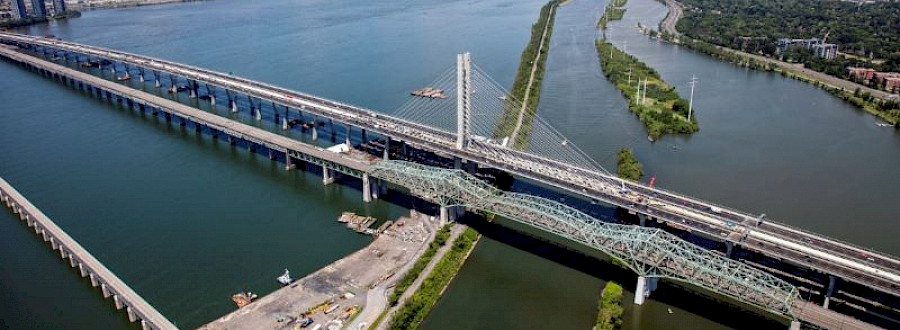
The Company has received the following applications for the AQ35001 Qualification Call:
Group 1: Dragados Canada
Group 2: New Horizon St-Laurent
Group 3: Champlain Heritage
Group 4: Kiewit Construction
In accordance with the terms of the call for qualification issued on March 8 and following the filing of applications received on May 28, 2019 at 3 p.m., the Jacques Cartier Champlain Bridge Corporation inc. starts the evaluation process.
Public launch of the Champlain Bridge Deconstruction project
The request for qualification for design-build services for the deconstruction of the original Champlain Bridge (2019-2023) was launched on March 8, 2019, and interested firms had until May 28, 2019 to make their submissions. The purpose of this request for qualification was to select three candidates who would then be invited to submit a proposal for the next step of the selection process.
The candidates who made a submission and who have qualified for the next step are (in alphabetical order):
Groupe Champlain Héritage
Kiewit Cie
Nouvel Horizon St-Laurent
JCCBI carried out a thorough and fair assessment of all submissions. An independent auditor (or external fairness monitor) was appointed to monitor the integrity of the submission evaluation process to ensure that the principles of integrity, fairness, and transparency were upheld and that the terms of the request for qualification process were followed.
The selected candidates will be invited to submit a proposal for this project. The proposal period will start the week of July 8 and last for 5 months.
The goal of this process is to select the tenderer whose proposal best meets JCCBI’s requirements. The proposal evaluations will then determine which contractor or consortium will be awarded the contract.
The management of the north and south approaches of the Champlain Bridge and the federal section of Highway 15 was transferred to Signature on the Saint Lawrence, the consortium responsible for the New Champlain Bridge Corridor project. The transfer includes operations, maintenance and traffic management over these sections.
As part of the New Champlain Bridge Corridor project, for the north and south approaches of the Champlain Bridge and the federal section of Highway 15 are transferred from the Corporation to the President of the Queen’s Privy Council for Canada. To ensure a smooth transition, the Corporation continues to oversee the operations of these sections.
Inauguration of the new Île des Sœurs bypass bridge
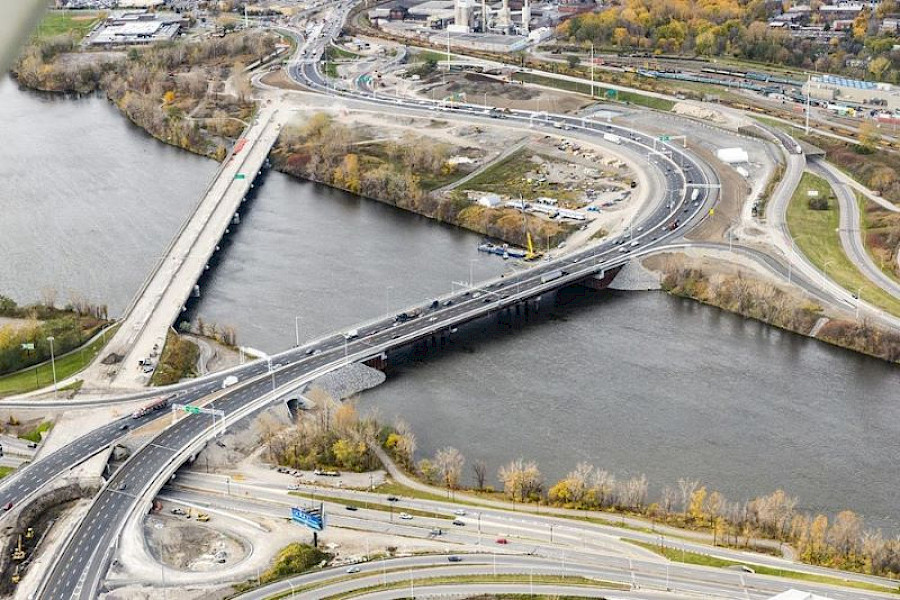
The construction of this temporary bypass bridge between Montreal and Île des Soeurs started in August 2013. The bypass bridge has the same number of lanes as the previous bridge as well as a wider bicycle path and a reserved public transit lane.
The bridge is no longer in service since October 2018.
The super beam was replaced with a modular truss. This innovative and highly effective reinforcement method was then deployed on all 100 edge girders from 2014 to 2018.
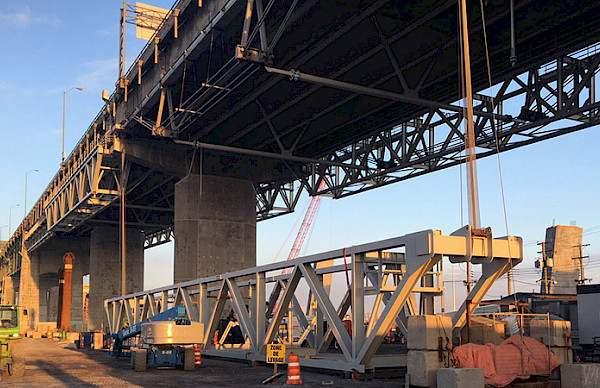
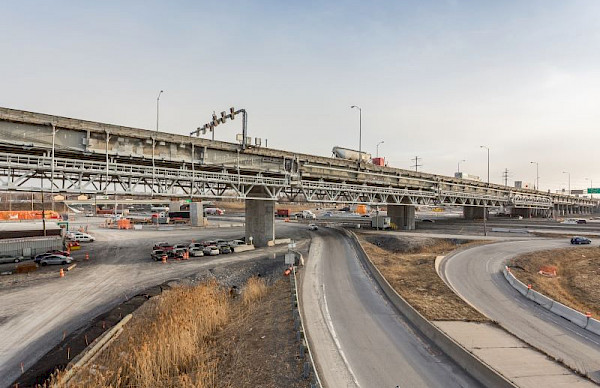
During an inspection in November 2013, a crack was detected on an edge girder towards the South Shore. The Corporation installed a 75-tonne prefabricated super beam to stabilize the cracked girder while maintaining traffic flow. To install the beam, four lanes of traffic had to be closed for two days.
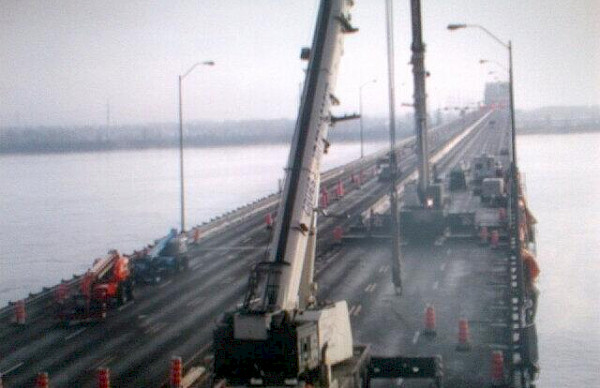
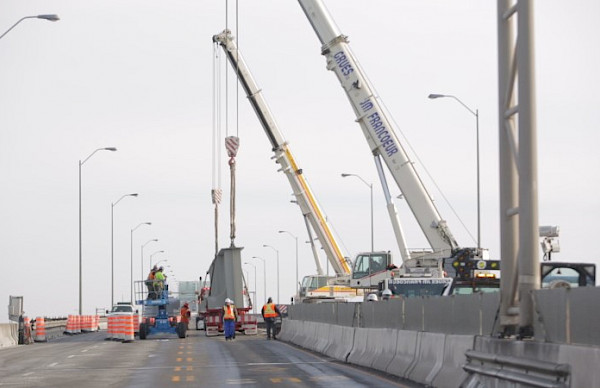

The Government of Canada announced that the Champlain Bridge would be replaced with a new one.
The toll was abolished on May 4, 1990 at 12:00 p.m.
Redecking of the Champlain Bridge
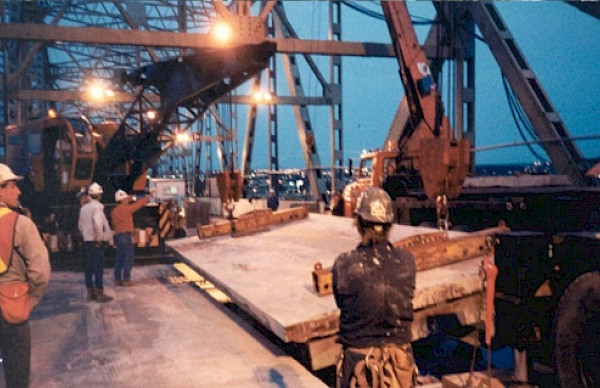
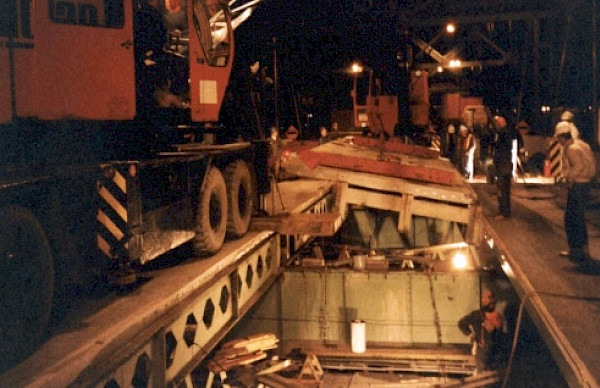
The first replacement in Canada of a concrete deck with a fully field-welded steel deck. The unique, durable and effective solution to lighten the structure won the Prix Méritas from the Ordre des ingénieurs du Québec thanks to the exceptional quality of this large-scale project.
The Corporation introduced a reserved against-traffic bus lane during rush hour. Although meant to be temporary, this bus lane was used to transport 30,000 people per peak hour until the bridge closed in 2019.
In 1978, The Jacques Cartier and Champlain Bridges Inc. was incorporated and became responsible for the Champlain Bridge, the Jacques Cartier Bridge, and a section of the Bonaventure Expressway and Highway 15.
This toll bridge opened on June 28, 1962 without an official ceremony. At the time, the only approach to the bridge was from Wellington Street in Montreal. The Champlain Bridge had six lanes — three in each direction — and a concrete median.
The construction of the Champlain Bridge cost approximately $35 million in 1962. Including the approaches and Bonaventure Expressway, the total cost was approximately $52 million.
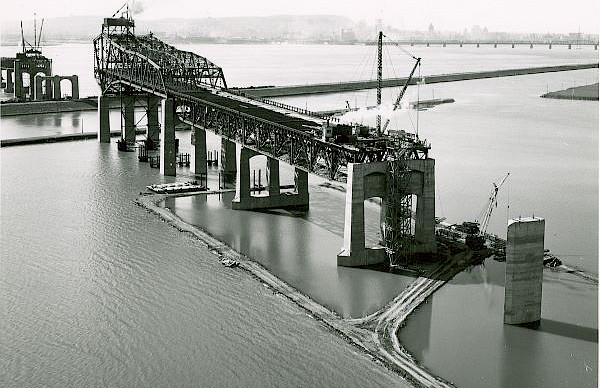

Photo credit (left) : Hans van der Aa
Photo credit (right) : Hans van der Aa
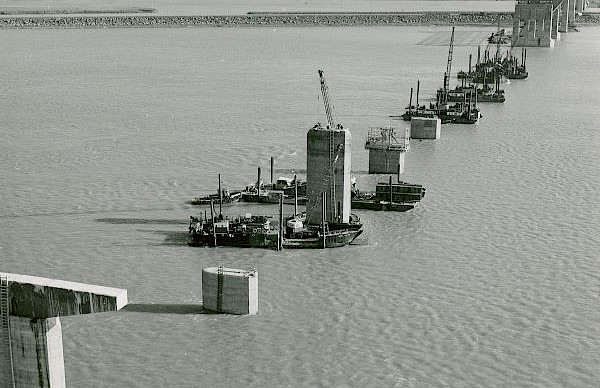
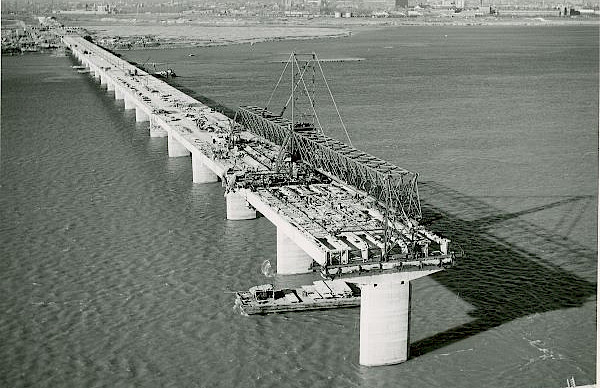
Photo credit (left) : Hans van der Aa
Photo credit (right) : Hans van der Aa
In 1958, it was officially named the “Champlain Bridge” in honour of Samuel de Champlain, who founded Quebec City in 1608.
At first, the structure was referred to as the Île des Sœurs Bridge, as it touched ground on this island. It was quickly renamed for the 350th anniversary of Quebec City.
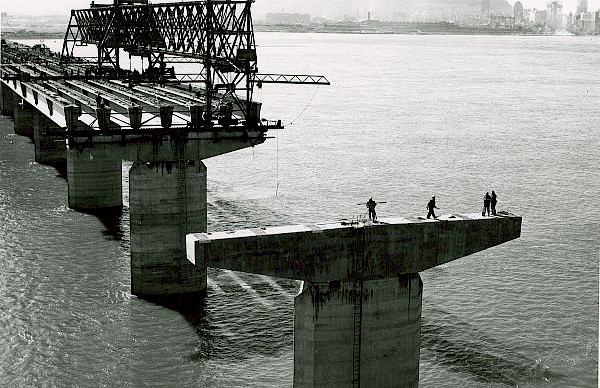
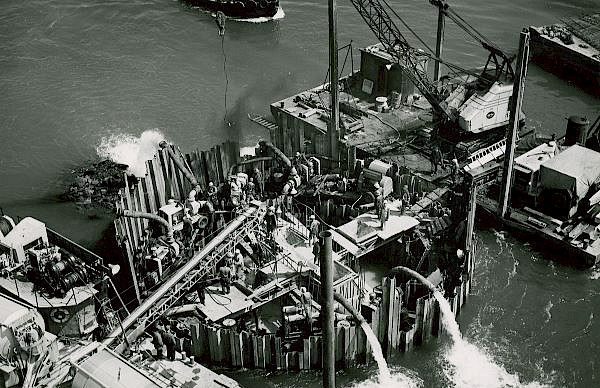
Photo credit (left) : Hans van der Aa
Photo credit (right) : Hans van der Aa
Construction of the bridge begins.
The National Harbours Board was put in charge of the project. At first, the bridge was called the “Nun’s Island Bridge,” as it crossed over Île Saint-Paul, which was also known as Île des Sœurs (or Nun’s Island).
The Honourable George Marler, the federal Minister of Transport at the time, announced that a toll bridge would be built over Île des Sœurs to the South Shore.
Philippe Ewart was hired to work on the construction of the Champlain Bridge because of his expertise in traffic flow. This engineer had to coordinate this vast project to create a direct connection between Montreal and the road network leading to Sherbrooke.
Did you know that Philippe Ewart was both an engineer and an author?
In 1956, the National Harbours Board, which was officially in charge of the project, held consultations with stakeholders to decide on the exact location for the new bridge. Once the route was determined, the design and construction work was awarded to Philip Louis Pratley, who died suddenly a year later. His son Hugh Pratley took over the reins and, to better manage the project, partnered with a trio of engineers, one of whom was Philippe Ewart.
The work started in 1957 and the bridge opened to traffic on June 28, 1962. Quebec’s harsh weather conditions along with tight deadlines and a small work force put considerable pressure on the project. Thanks to sophisticated tools and an innovative use of girders, the Champlain Bridge became the source of great advances in construction techniques for multiple-span bridges.
After this experience, Ewart and his associates went on to write a number of books, including works on highway tolls and urban traffic.
In 1844, French mason Philippe Fougerolle founded the company that still bears his name. The Fougerolle company worked on the design of many large-scale structures and was responsible for developing the construction of the Champlain Bridge.
What do we know about the Fougerolle company?
The company’s story started in France. After finishing work on the Canal du Nivernais, Philippe Fougerolle received the royal engineering seal to work on roads and bridges in Nièvre. With this recognition, Fougerolle received a stamp of approval that let him submit tenders for major projects. From the Mauvages Tunnel to the Tancarville Bridge, Fougerolle had a hand in the construction of many viaducts, tunnels and bridges in France.
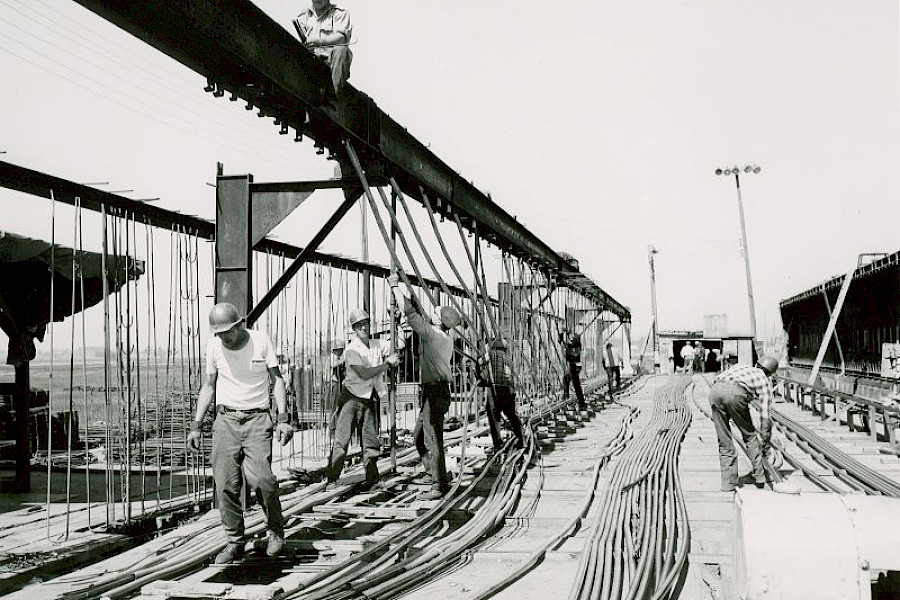
Photo credit: Hans van der Aa
Many years later, and thousands of kilometres away in Montreal, it was announced that a toll bridge would be built over the St. Lawrence River. The National Harbours Board invited representatives from Greater Montreal cities and governments to decide on the location of the structure. The design of the plans and specifications and the supervision of the work was handed over to the Pratley de Montréal consulting engineering firm. To enhance the project coordination, the Champlain Bridge construction project was divided into seven sectors, including the access ramps, metal structure and concrete deck. The Fougerolle company from France was hired to oversee the development of the entire project. Five years after the first construction contract was awarded, the Champlain Bridge opened to traffic in June 1962.
A graduate of the École Polytechnique de Montréal and the prestigious Massachusetts Institute of Technology, engineer Roméo Valois co-founded the Lalonde et Valois consulting engineering firm. Although the National Harbours Board was tasked with managing the construction of the Champlain Bridge in 1955, engineering consulting firm Pratley de Montréal was hired to create the plans and specifications and oversee the work. These engineers decided to partner with Lalonde et Valois to enhance the project coordination.
What do we know about Lalonde et Valois?
Valois partnered with a former classmate, Jean-Paul Lalonde, in a bold move to found his own engineering company in 1936. That year, the Quebec ministry of highways injected $50 million in the construction of roads and bridges. As the pair wanted to work on the problem of soil bearing capacity, a year later they acquired National Boring and Sounding, a company that specialized in the study of land that supports building, bridge and tunnel foundations.
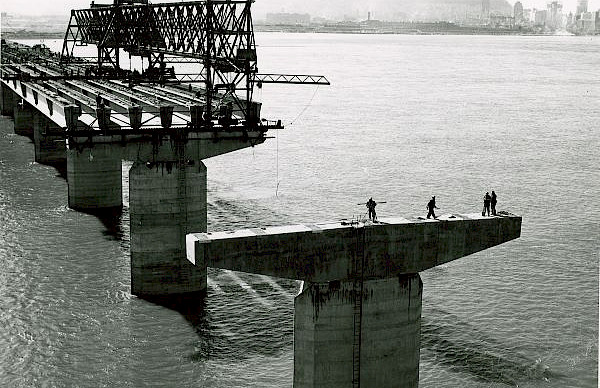
The firm was able to expand its business even amidst the economic turmoil caused by the Second World War. Lalonde and Valois worked on major national projects, including over two hundred projects that dealt with major construction, school expansions, and renovations.
Photo credit: Hans van der Aa (May 5, 1961)
Quebec engineering comes into its own
Despite the heavy involvement of foreign engineers in major construction projects, the alumni association of the École Polytechnique de Montréal succeeded in positioning its graduates at the highest levels of the province’s civil service. After the launch of the $50-million transportation infrastructure program, Francophone engineers from Quebec moved into leadership positions for important infrastructure projects, such as the Champlain Bridge and the Honoré Mercier Bridge.

